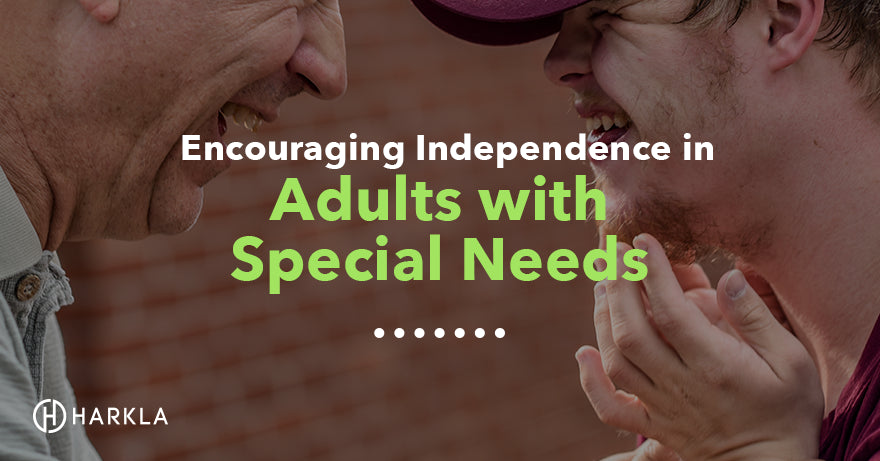Your Cart is Empty

When a person has a disability, a range of skills can be affected and limit one’s ability to be independent. Sometimes these skills can be accommodated for with assistive technology tools and strategies, or remediated with direct services from a qualified clinician. Other times, solutions can be found by modifying the tasks or environments to better meet the needs of the person with a disability.
Occupational therapists support these skills that people need to live at their most independent level. Skills for working, playing, learning, and daily living all contribute to someone living their most purposeful, meaningful life.
Regardless of whether you have a child with cerebral palsy, a high-schooler with learning disabilities, or an adult with autism, immeasurable value is found in maximizing, restoring, and enabling independence across the lifespan and across activities.
This Go-To Guide provides useful resources for additional support and a thorough understanding of the importance of helping individuals with special needs learn the skills to become more independent.
What are Independent Living Skills?
The following are all examples of independent living skills (Independent Lifestyles)
One’s ability to be independent with these skills can directly affect self-esteem and perceptions of one’s value to the larger society as a whole.
To encourage, foster, and build independent living skills is to positively impact a person’s confidence and willingness to take risks on their own!
New learning and personal growth happen through risk-taking.
The Progression of Learning Independence
When children are just developing cognitive, motor, social, and language skills, the expectations for independent living skills are minimal. Children at this young age cannot multi-task or problem solve in order to truly be “independent.”
As parents, we set our children up for success by choosing “just right challenges” for them to feel independent and be willing to try new things on their way to new learning.

We start by asking toddlers to help with self-feeding, undressing, choice making, and basic hygiene tasks like brushing their teeth or combing their hair. Preschoolers quickly learn these basic routines and eventually develop skills to handle more multi-step, complex tasks like dressing themselves, washing hair, and taking care of personal items like coats, backpacks, and shoes.
By elementary school, independent living skills move beyond just self-care activities (bathing, dressing, feeding) to higher-level skills that will shape their abilities as adults. Maybe they engage in simple meal preparation like making their favorite PB&J sandwich, handle money to pay for their school lunch, or complete simple chores to contribute to the household management.
We all started our journey to independent living with the help of these elementary activities and learned how to gradually take on responsibility while being mindful and reflective of our individual performance.

Fast forward to post-high school years when you now have the adult responsibilities of a job, car, and your own household to manage - whether it’s a dorm room shared with friends, your first rental apartment, or a paid space in your parent’s basement! You hopefully have developed enough independent living skills to manage on your own and from here on out, you’ll be refining the more complex skills of financial management, personal growth, and making long-lasting community connections.
This progression of developing independent skills is fairly consistent for all of us - give or take a few bumps in the road along the way. But when you have a disability, whether it’s a cognitive, language, social, motor-based disability, or autism, acquiring independent skills may not be as straightforward.
When you are a child or an adult with special needs, parents and caregivers need to consider whether or not to focus on “functional” living skills rather than “independence.”
What does functional living skills mean?
If a person’s disability is such that they may not have the ability to be safe living alone or make appropriate judgment calls independently, the focus becomes on maximizing his/her independence to the most functional level.
The Alpha School in New Jersey lists their “Top 10 Essential Life Skills for Success” for people with special needs as:
Their “curriculum” for functional living skills is an example of how people with special needs may benefit from direct instruction in some of the very basic independent living skills that you and I developed naturally.
For example, fully functioning, independent adults hold a job and manage their finances to do a range of tasks like shopping, bill pay, savings, credit card management, and retirement planning.
Adults with autism often learn these essential skills within the greater context or understanding that the person will likely need ongoing supervision as an adult.
These skills can be part of an IEP plan and specialized instruction can support these functional goals.Some people with special needs will need the support of another trusted advisor to help with the more complex of those tasks, but the essential life skills of functional math can foster independence with shopping and community access skills (i.e. bus money, making change).
When a student receives special education services under an Individualized Education Program (IEP), he/she is entitled to receive services until they turn 21 years of age, beyond graduation from high school. By the time a student turns 16, transitional programming recommendations must be made.
The end goals of a transition plan are to prepare a student to be an independent young adult either by securing vocational training, pursuing postsecondary education, seeking jobs and employment, or planning for independent living.
For more information on transition plans within the IEP, check out this resource from Understood.org. Depending on the school district’s resources and programs, some students may attend a pre-vocational transitional program between 18-21 years old to continue to target IEP skills in a different environment. For more information on transitional programs in your area, contact your child’s case manager.
Transition planning support can also be found on the Office of Special Education and Rehabilitative Services website. Their resources include webinars, guides to the transition process, and transition activities for parents and districts to consider.
Reflect on your own opinions of your professional life. Do you work to live? Or, do you live to work? One question is driven by finding a passion for what you do to enhance your life (the latter), while the former is driven by working to pay for a lifestyle. For so many of us, these two questions lead us to finding a job that interests, sustains, and provides for our lives.
The value of having a job is much more than just income. It provides meaning and purpose, social opportunities, and a sense of accomplishment. If you’re lucky, you do what you love and love what you do!

For people with disabilities, the reasons for getting a job are the same as anyone else’s.
Unfortunately, data from 2017 reports that only 18.7% of people with a disability were employed as compared with 65.7% of non-disabled people (Bureau of Labor Statistics).
Efforts to create meaningful employment opportunities for people with disabilities are ongoing but, there are resources that oversee vocational programs at a state and federal level.
The United States Department of Education has an Office of Special Education and Rehabilitative Services that seeks “to provide leadership and resources to assist state and other agencies in providing vocational rehabilitation (VR) and other services to individuals with disabilities to maximize their employment, independence and integration into the community and the competitive labor market.” These services ensure that people with disabilities are provided with job opportunities that match their ability levels.
Each state has a division of vocational rehabilitation services to help a person with a disability find and acquire a job. For reports on funding as well as a list of contacts for programs in your state, check out this link here.
It is important to remember that people with disabilities are protected from discrimination under Section 504 of the Americans with Disabilities Act (ADA 1990). Employers must provide reasonable accommodations for employees with a disability to perform any essential job functions. Your state’s rehabilitative services program will help match the appropriate job functions to your child’s individual strengths and abilities.
In 2011-2012, an estimated 11% of all students attending college reportedly had a disability (National Center for Education Statistics).

Just as there is a range of college options for the typical student, students with disabilities can choose from community, 2-year, and 4-year college programs. They can live on or off campus, or attend online. They can benefit from the same college experiences as their non-disabled peers.
If you are or have a young adult with a disability, your legal rights extend beyond your educational career in high school but they do differ slightly.
There are no IEPs in college -- instead, the Americans with Disabilities Act extends Section 504 protections to college students who disclose their disabilities. This means that, while accommodations will be available to students who require them in order to access their educational environments, specialized instruction, and services beyond that are not mandated.
Some colleges offer learning centers for tutoring assistance, but these services are dependent on the program that the student chooses and the range of services will differ. For more information on college disability services, check out this article from Understood.org.
Should you choose to pursue a college education, there are 504 protection that are important to know. Under Section 504, a college or university may not:
(Community for Accredited Online Schools)
Regardless of what college institution you choose, don’t forget to explore assistive technologyoptions that may offer additional independence. Human scribes or readers can be replaced with speech-to-text and text-to-speech technology; e-books and audiobooks make digital accessibility of college curricula more attainable; electronic planners/calendars, note taking software, and mobile technology can help students with organizational skills needed to manage multiple college courses. If you haven’t been exposed to these technologies in high school, be sure to seek out your college’s disability services program to explore what they might be able to offer.
Levels of independence vary based on a person’s developmental, motor, and/or cognitive abilities and should always be taken into consideration alongside the environment and necessary tasks.
Regardless of whether a person will be truly independent, there is value to be found in teaching essential life skills and promoting independence within meaningful activities. Transitional planning, vocational programs, and post-secondary educational opportunities are all available to people with disabilities and a range of supports exists to protect one’s legal rights to those opportunities.
If you have helpful tips or strategies to encourage independence in individuals with special needs, please share with us by commenting below!
Comments will be approved before showing up.


Jameelah Bilal-Jones
June 15, 2021
I am 43 that have MS. I get Disabilty but is thinking going back to school. I have Tremors in my right hand. What should I take that would be easier for me and if I do will it mess up my disability.